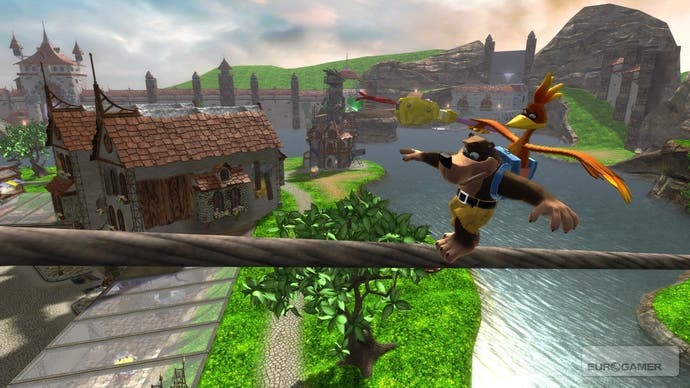Banjo-Kazooie: Nuts & Bolts
Spanner time.
In visual terms, everything remains as colourful and cheerful as you'd expect from a Banjo-Kazooie game. The level of detail Rare has managed in such enormous zones, however, is incredibly impressive. In the E3 demo, every texture and surface has been carefully considered - the team is aiming for a "constructed" look to the whole world, something which it's achieved by leaving the obvious scars of human construction on everything in the zone.
Grass looks like a woven fabric up-close, and has stitch marks at the edges where it joins another surface. Mountains and hills are constructed of bricks and concrete, sheer cliffs have rivets and metal plates on them. Overhead, metal clouds are suspended on barely visible wires. The effect is superbly consistent, giving the whole game an endearing, patchwork feel.
The character designs, of course, retain the slightly screwball, over-the-top nature that made the original Banjo such fun. Moreover, there's an interesting and potentially funny idea at work here, with the same characters appearing in each and every world - but often in radically different roles. This isn't to economise on character design work - it's done with a knowing nod and distinctly played for laughs, with the team happily describing each character's role in the different worlds as "amateur dramatics".
The prevalence of pre-built vehicles in the E3 demo is vital to allow people to quickly get zooming around the world - but in the final game, there's a huge focus on the whole process of building your own vehicles. The hub world, Showdown Town, is the closest Banjo gets to traditional platforming action as you drive around a vehicle that looks a bit like a shopping cart, collecting crates by solving various puzzles or platforming through sections of the level.

Upon bringing crates back to Mumbo's Garage, you earn parts for your vehicles - and while there'll always be an option to have Mumbo create a vehicle for you from the parts you've got, most players will want to dive in and build their own. This uses a fairly straightforward 3D positioning editor, in which you place the various chunks of vehicle as if you were building something from LEGO. As long as it's got fuel and an engine, it'll move - wheels or wings help, obviously - and the other gadgets you add are totally up to you and what you've managed to find so far.
This, of course, is how Banjo's progression is going to work - and it's in this that the game's platforming roots are most obvious. Acquire a new gadget or vehicle ability, and new parts of the world will open up to you simply by dint of finally being able to get there. A non-linear progression through the game's missions, which open up as you gain access to "Game Globes" around the world, is another major facet of this - while for those who get really obsessed, we can see near-endless replayability as you tweak your vehicles to try and shave seconds and milliseconds off your scores at the various challenges (complete with Xbox Live leaderboards, naturally).

Rare has unquestionably had a tough time of it since its acquisition by Microsoft - something which the studio addresses in Banjo in a typically self-deprecating British way, with the E3 demo level including a massive dustbin full of copies of Grabbed by the Ghoulies, its Xbox flop. Later in the level, we try to lift the dustbin, but it tips over in mid-air, spilling Xbox game cases all over the floor.
With Viva Piñata, however, it found its feet creatively if not commercially - and Banjo looks like it will be the next major step on Rare's road back to good fortune. Whether that's enough to make it into a bona fide hit or not is hard to say, but on the strength of the E3 showing, it's definitely going to be a lot of fun.





